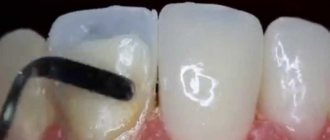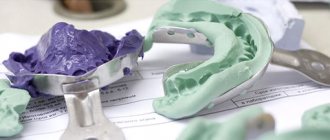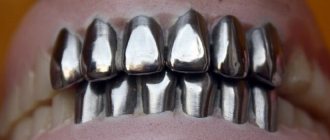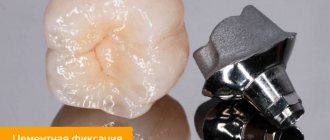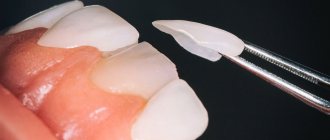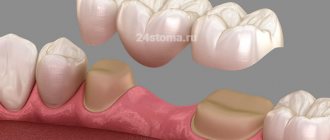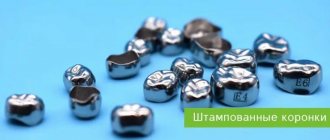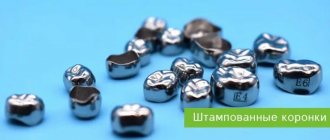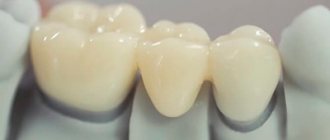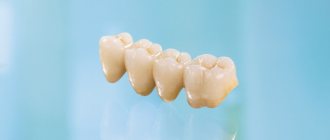A 25-year-old patient came to the clinic with a fairly popular, but, in her case, specific request to have a tooth extended. It was broken in childhood, but the patient found a broken piece, and kind dentists glued the piece back. According to the patient, he looked quite tolerable, although he was a little shorter than his neighbor, and he even tolerated orthodontic treatment well.
Treatment period is 3 weeks.
Price
| Feldspar veneer on a refractor | 45,000 rub. |
A patient came to the clinic with these teeth.
The reason for the patient’s visit to the clinic was that soon the composite material on which the previously chipped part of the tooth was glued became less aesthetically pleasing and stood out significantly in relation to the color of the dentition as a whole. This often happens with composite fillings, which are directly located in aesthetically important areas and often come into contact with coloring substances: coffee, tea, red wine, tomatoes. The difference in the length of the dentition has become more noticeable and noticeable over the years.
The picture shows a glued fragment of a broken tooth.
During the consultation survey, it was also found out that the adjacent central incisor also became darker than the lateral incisors for unknown reasons.
The patient was offered several alternative methods for restoring aesthetics, such as composite restoration and the popular, perhaps one of the most effective methods today - ceramic veneers on a refractor.
However, due to his young age and the presence of practically intact teeth (with the exception of a chipped tooth), it was decided to restore the shape and color of the two front teeth with ceramic veneers made of feldspathic ceramics, made on a refractory (fireproof) model.
Why are we the best in the ceramic veneers market?
- our doctors install more than a thousand veneers per year
- own dental laboratory
- we use only imported materials and medicines
- quality control at all stages of treatment
- absolute guarantee on design and work
- we offer veneers from economy class to premium highly artistic ones
- reviews from our patients are better than any words
- promotions and special offers allow you to save significantly
Call and make an appointment by phone 8-800-1000-234
Where is the best place to place veneers?
It's no secret that aesthetic operations such as the installation of veneers should be carried out only in serious and trusted clinics. From the best specialists. They are professionals in their field, with thousands of successfully performed veneering and aesthetic dental restoration operations behind them.
Why do we offer installation of veneers here, in our clinics?
All-Russian
The rating of private dental clinics in 2022 confirmed
the leadership
of the German Implantology clinics and the “Clinic over 3 years old”.
11,000 of the best
Russian dental clinics from more than 110 cities fought for the right to be the first, and we again became the best in Russia!
The award ceremony took place on September 23, 2022
within the framework of the largest dental exhibition in Russia -
DENTAL EXPO 2019
and
on September 22, 2022
at the
DENTAL EXPO 2020
.
In the category “Clinics up to 3 years of age” - the clinic of the Research Center in Ramenki:
In the category “Clinics over 3 years old” - the clinic of the Scientific Research Center on Kievskaya,
which has been successfully performing dental implantation for more than 9 years:
What is the difference between composite veneers and ceramic refractor veneers?
Ceramic veneers on a refractor occupy a special position in dentistry due to their unique properties. Only ceramics, unlike composite and glass ionomer materials, have the best aesthetic effect. Composite veneers, even of the highest quality, are essentially plastic. Composite is a material consisting of several components that shrinks and changes color over time. Due to the properties of ceramics and the varied palette of colors used in the process of creating veneers, it is possible to achieve ideal accuracy in conveying the color and shape of the tooth.
Only with the help of ceramic veneers on a refractor can you achieve a natural shade and natural light transmission. All-ceramic veneers do not lose their natural shine, they are strong and durable, do not stain over time and retain their original shape and texture.
Manufacturing stages
The key differences between refractory veneers and conventional ones lie in the method of creating the plates. The main task of dental technicians is to make a ceramic plate that would most accurately convey all the features of the tooth on which it will be fixed in order to obtain a tight fit. Without meeting these conditions, the veneer cannot be reliably and efficiently installed on the tooth.
When creating virirs with a refractor, everything happens a little differently, although the initial stages of forming microprostheses are similar:
- An orthopedic doctor photographs the patient’s teeth and takes an impression of them. This is necessary for 3D modeling of a future smile;
- diagnostic wax-up - creating wax models for veneers so that the patient can try them on and evaluate the result. Also, fittings and wax models are needed so that the doctor receives the most accurate picture of existing dental defects; this is important to consider when creating veneers;
- if necessary, preparation, or grinding, of teeth, during which the doctor removes a minimum layer of tooth enamel. However, in some cases, when creating veneers using a refractor, you can do without preparation;
- if the teeth still undergo grinding, the doctor installs temporary veneers on them to protect the teeth from external influences;
- creation of permanent veneers - the formation of a fire-resistant base, followed by layer-by-layer application of ceramic mass and baking in an oven;
- Before fixing to the teeth, the finished veneers are etched and washed with a special solution to achieve a strong connection with the front surface of the tooth;
- installation of permanent veneers using dental cement.
Installing veneers is a lengthy process that requires patience and several visits to the clinic. The production of plates alone in a dental laboratory takes from 1 to 3 weeks. Accordingly, the entire process from the first visit to an orthopedic dentist to the fixation of finished veneers can take about a month.
Can a ceramic veneer made with a refractor crack or break?
After manufacturing, ceramic veneers on the refractor are a thin plate. It looks like a translucent scale of a given color.
Of course, if the veneer is dropped or hit with a heavy object, it will crack and break. But, as soon as the doctor attaches this thin plate to the tooth with a special photopolymer composition, the veneer and tooth form a strong, monolithic connection. According to its technical characteristics, a ceramic veneer on a refractor is harder than tooth enamel. The use of veneers does not require any special conditions. The only restriction is not to test their strength and not to crack nuts with your teeth, not to chew through the wire and not to open bottles. Heavy loads can lead to chipping of your own tooth and detachment, compromising the integrity of the ceramic veneer.
Achievements of modern dentistry
Previously, massive plates were installed that required the removal of part of the tooth. Now the veneer is an ultra-thin (up to 0.4 mm) ceramic plate. Such thin structures are made of durable ceramic materials. Even the thinnest veneer can withstand serious loads.
Veneers are considered an aesthetic area of dentistry, due to their main function - changing the shade and shape of the tooth. There is also a functional significance. Ceramic coating allows you to hide visual enamel defects, eliminate interdental spaces, and hide pigmentation. In addition, veneer performs a protective function - ceramics are resistant to abrasion, which cannot be said about natural enamel. Ceramics do not retain plaque and pathogens.
Can teeth be treated after installing ceramic veneers?
Before installing ceramic veneers, the doctor must examine the patient’s oral cavity and carry out the necessary procedures: treats caries, removes plaque, whitens teeth. If caries subsequently occurs on the tooth with the veneer installed, treatment is carried out and a filling is installed. Also, after installing ceramic veneers, in order to extend the life of the plates, it is necessary to regularly carry out professional comprehensive cleaning of the oral cavity.
How do different ceramic crowns differ from each other?
One of the first articles for patients that once appeared on my blog was devoted to different types of crowns that are used in dental prosthetics. Today I will make a small addition dedicated to different types of the most aesthetic prosthetics - metal-free crowns . What are they? And how are they different? Let's get a look.
Today, dentists use 3 types of metal-free structures in prosthetics: crowns made of solid ceramics, frame crowns without ceramic lining, and, finally, frame crowns with ceramic lining.
All-ceramic crowns
Sometimes you can also hear their name in professional slang: “refractor” or “crowns/veneers on a refractor.”
Using this technology, crowns and veneers are made from solid ceramics. They are very thin and allow you to achieve the best results in terms of aesthetics.
Such designs can be made on teeth even without grinding them or with very minimal grinding (0.2-0.4 mm). This is best suited for well-preserved anterior teeth and the most common indications are aesthetic, i.e.
correction of the shape and color of a less than ideal natural tooth without serious damage.
A natural doubt arises about the strength of such weightless structures.
That's right, they are very thin and fragile, but... exactly until the moment they are glued to the tooth. Once the doctor has successfully and correctly glued such a crown or veneer to a tooth, they form a monolith that is quite difficult to destroy. Although theoretically, chips of the ceramic itself are still possible.
But there are no special restrictions in using it for its intended purpose - everything that can be bitten with your own teeth can be bitten with such crowns. Opening bottles, chewing wire, husking seeds and similar violence against teeth does not apply here.
It is advisable to avoid these activities, even if you have all your teeth like nothing else.
In terms of cost, this is usually the most expensive type of prosthetics, because very difficult to implement at all stages. It requires the doctor and dental technician to have mastery of their specialty, increased accuracy, longer work hours and more working hours.
Frame crowns without ceramic veneer
These crowns are made from zirconia or lithium disilicate (a material better known under the brand name e.max ). These materials in their pure form have high strength, but reduced aesthetic characteristics. This makes it ideal to use these structures for prosthetics of lateral teeth.
Here, impeccable aesthetics is often not as important as the durability of the material. After all, it is the lateral teeth that bear the maximum chewing load. An additional advantage of non-ceramic-veneered crowns is that they are virtually impossible to chip. Because
The frame material itself is quite difficult to break off, and the much more fragile ceramic lining is missing.
As for aesthetics, on the side teeth it is quite possible to accept monochrome, lack of translucency and other aesthetic “issues” that bring the appearance of the artificial crown as close as possible to a natural tooth. Most often, designs made from solid zirconium dioxide or solid e.max are similar to plastic crowns - primarily due to their opacity and monochrome.
At the same time, it must be said that materials evolve almost every day. Already today, translucent zirconium dioxide has appeared in our practice, crowns made of which look almost “alive”.
And with the proper skills of a dental technician, it is only possible to give them a completely aesthetic appearance through surface staining of solid structures, and you will not immediately understand which is an artificial tooth and which is a natural one.
As for the cost, the production of such structures in a dental laboratory has a simplified work cycle, involves less manual labor, and accordingly, this makes them less expensive.
Contraindications
Contraindications are the same as for conventional veneers:
- Bruxism – involuntary grinding of teeth during sleep;
- significant destruction of the crown of the tooth.
- significant bite defects;
- diseases of the teeth and gums (caries, pulpitis or periodontitis);
- tooth mobility;
